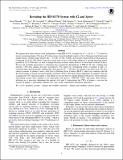Revisiting the HIP 41378 System with K 2 and Spitzer
Author(s)
Berardo, David Anthony; Crossfield, Ian Jm; Werner, Michael; Petigura, Erik; Christiansen, Jessie; Ciardi, David R; Dressing, Courtney; Fulton, Benjamin J; Gorjian, Varoujan; Greene, Thomas P; Hardegree-Ullman, Kevin; Kane, Stephen R; Livingston, John; Morales, Farisa; Schlieder, Joshua E; ... Show more Show less
DownloadPublished version (2.845Mb)
Publisher Policy
Publisher Policy
Article is made available in accordance with the publisher's policy and may be subject to US copyright law. Please refer to the publisher's site for terms of use.
Terms of use
Metadata
Show full item recordAbstract
© 2019. The American Astronomical Society. All rights reserved. We present new observations of the multiplanet system HIP 41378, a bright star (V = 8.9, K s = 7.7) with five known transiting planets. Previous K2 observations showed multiple transits of two Neptune-sized bodies and single transits of three larger planets (R P = 0.33R J, 0.47R J, 0.88R J). K2 recently observed the system again in Campaign 18 (C18). We observe one new transit each of two of the larger planets d/f, giving maximal orbital periods of 1114/1084 days, as well as integer divisions of these values down to a lower limit of about 50 days. We use all available photometry to determine the eccentricity distributions of HIP 41378 d & f, finding that periods ≲300 days require non-zero eccentricity. We check for overlapping orbits of planets d and f to constrain their mutual periods, finding that short periods (P < 300 days) for planet f are disfavored. We also observe transits of planets b and c with Spitzer/Infrared Array Camera (IRAC), which we combine with the K2 observations to search for transit timing variations (TTVs). We find a linear ephemeris for planet b, but see a significant TTV signal for planet c. The ability to recover the two smaller planets with Spitzer shows that this fascinating system will continue to be detectable with Spitzer, CHEOPS, TESS, and other observatories, allowing us to precisely determine the periods of d and f, characterize the TTVs of planet c, recover the transits of planet e, and further enhance our view of this remarkable dynamical laboratory.
Date issued
2019-04Department
Massachusetts Institute of Technology. Department of Physics; MIT Kavli Institute for Astrophysics and Space ResearchJournal
Astronomical Journal
Publisher
American Astronomical Society